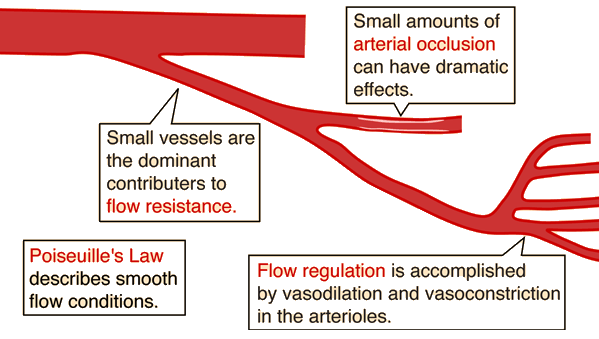There are two equations to keep in mind when looking at mechanics of blood flow:
1. Pressure (P) = flow rate (Q) x resistance (R)
2. R = (8 x u x L) / (pi x r^4) (where u = viscosity, L = blood vessel length, r = blood vessel radius)
The second equation applies to fluids that have a smooth flow, are incompressible (fluid density remains constant despite changing pressures) and are Newtonian (this means the viscosity doesn't change with stress, so stress is linearly proportional to strain rate). These assumptions simplify the calculations involved, and blood flow meets all the assumptions.
Assuming simple, normal physiological conditions, the blood viscosity and length of blood vessel are usually constant, so resistance is sharply affected by change in blood vessel radius. By combining both equations, we will get:
P = (8 x u x L x Q) / (pi x r^4)
Since we are measuring changes in pressure, we can treat blood flow to be constant, and so blood pressure is inversely related to radius of blood vessel. Now take a look at the following diagram:
Blood is pumped from the ventricles to the aorta to arteries, and the actual pumping of the heart contributes to a high pressure environment of blood flow in the arteries. Capillaries have very low blood pressure since they are arranged in parallel, which increases their cross sectional area and thereby significantly reducing resistance and pressure (think of capillaries arranged similarly to resistors in parallel). The low pressure environment is necessary to avoid damaging the capillaries and allow for more time for gas and nutrient exchange between blood cells and tissues.
Now blood is moving from high pressure environment in arteries to low pressure environment in capillaries. How does this happen? It's due to smaller and more flexible smaller arteries and arterioles that can more readily adjust for pressure drops through changes in blood vessel radius via vasodilation/vasoconstriction.
Pressure changes should be minimal in capillaries to avoid disrupting gas and nutrient exchange between blood cells and tissues. Minimal pressure changes also important to avoid losing extra fluid across capillaries and into tissues that can potentially lead to swelling and edema.



